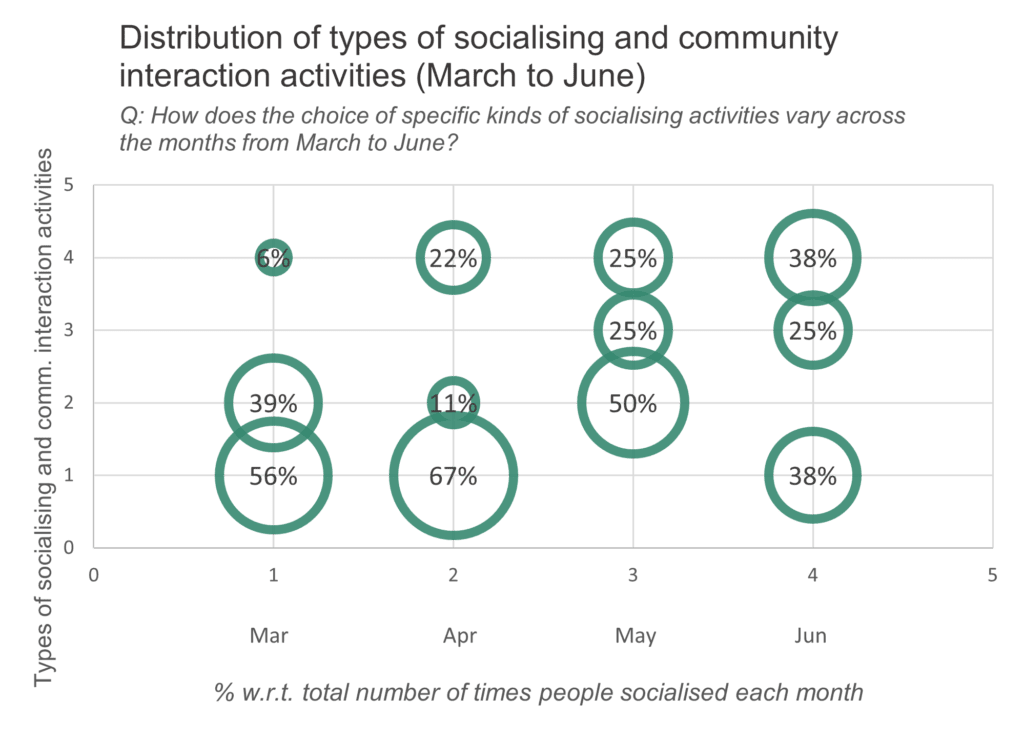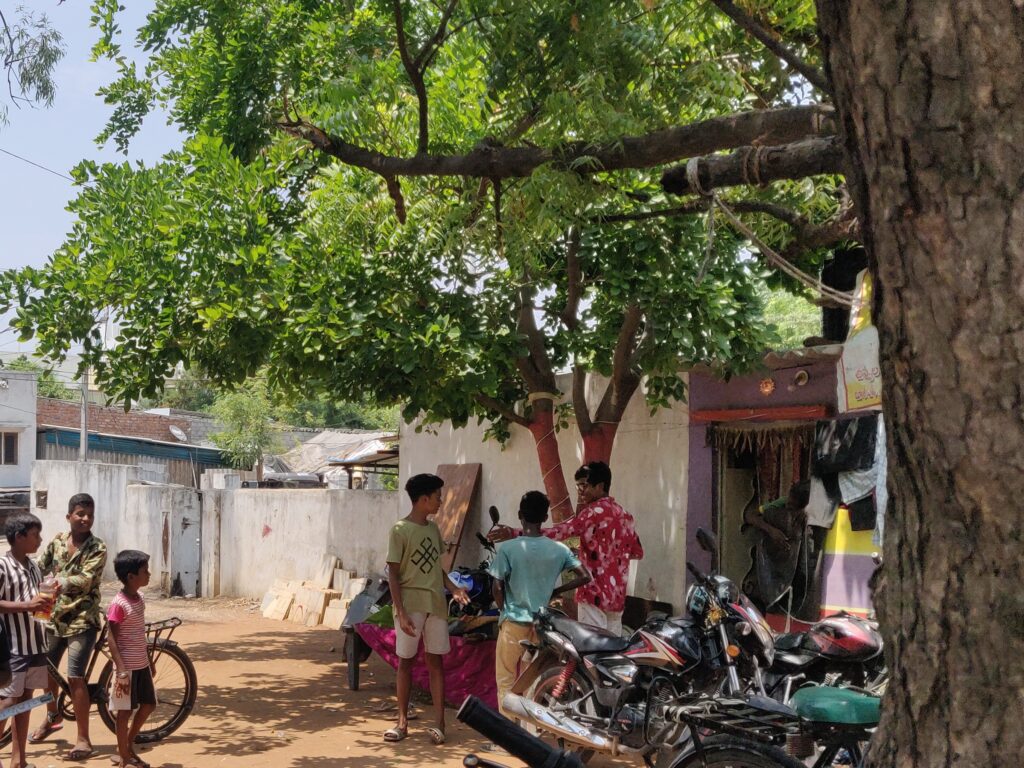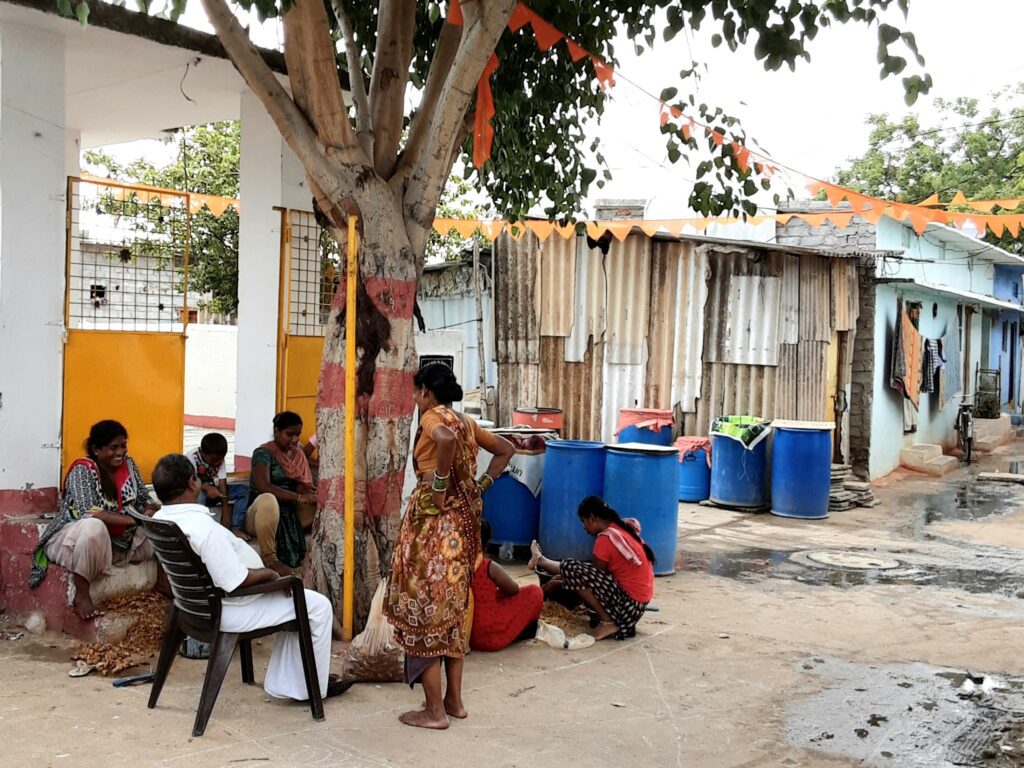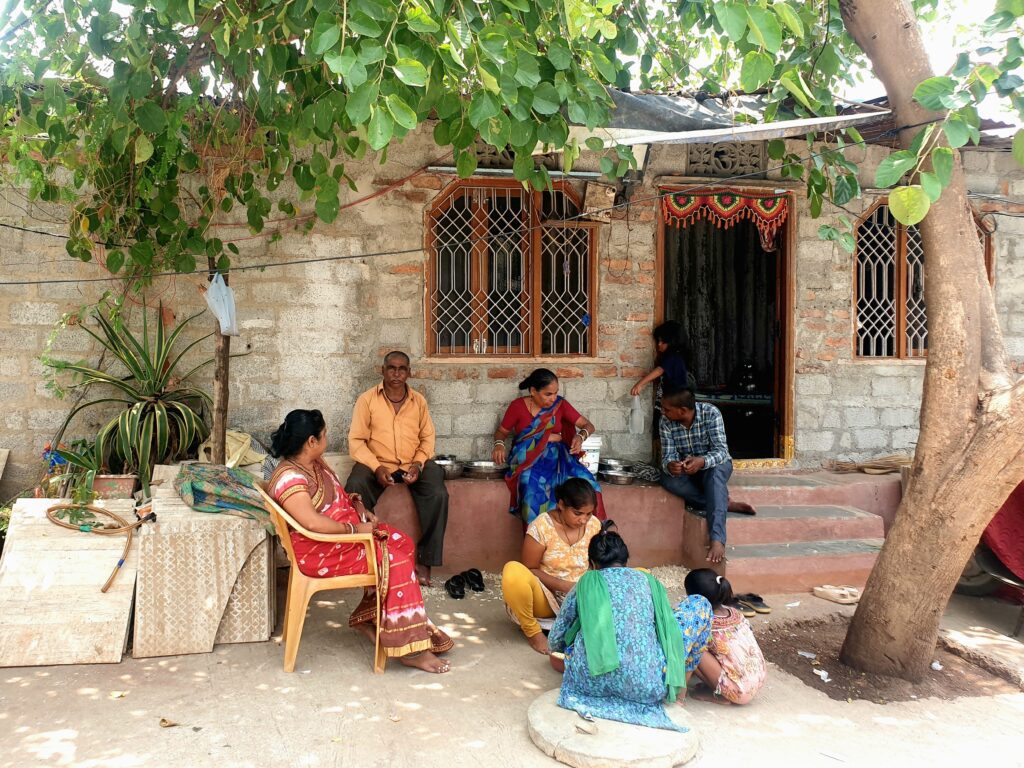From engaging in everyday banters while sitting under a tree, to taking important life decisions while chatting at a tea-stall, social interactions with friends, neighbours, and relatives, form an important part of the everyday lives in Singareni Colony. Some kinds of socialising activities are related to conducting and attending life events and social events, while some are a part of people’s ‘daily’ lives. A typical understanding of socialising refers to it as an activity that takes place with a prior intention to interact and socialise. However in Singareni colony, social interactions take place in several forms. Bastis often remain outside/off the grid of public infrastructure and services. They lack access to climate responsive building arrangements, as well as access to steady sources of energy needed for various typical cooling practices. People of Singareni socialise, when they spend ample time outdoors in hot summer afternoons and evenings to combat the discomfort led by the hot and humid indoors of their houses, and frequent power cuts (refer table 1), as a way of de-stressing and solace. Similarly, a group of women can often be seen chatting, engaging in informal discussions with each other while peeling ginger and garlic, or while separating chilli stalks that many women in Singareni do for living.
D, a local alcohol seller in Singareni is often seen working, sitting, and in fact eating at an outdoor spot opposite to her house, meanwhile chatting with other women of the alley. She says, such conversations ease her day out. Often when sewage water overflows from the manholes right outside her house, and has a stench, she eats outside with her friends.
– About a 25+ years old respondent and her preferred place of socialising
(Excerpt from Time-activity-perception study)
But very often such interactions that carry immense emotional, mental and physical value, and the spaces that encourage such interactions are undervalued and remain even unrecorded as important daily activities. Out of the total 1874 responses (from 174 surveys) showing all the daily activities of respondents between March and June, only 55 were marked as ‘socialising’.
This piece analyses the data collected as part of the time-activity survey from 47 respondents (29 women and 19 men), where respondents have mentioned ‘socialising and community interaction’ activities as part of their daily activities. This quantitative study places itself on the backdrop of qualitative field notes and observations that captures the otherwise ignored nuances of socialising activities in Singareni. Different kinds of socialising and community interaction activities take place in varied kinds of indoor and outdoor spaces. It is interesting to examine whether and how such spaces respond to the needs of people in Singareni throughout the year. As part of the scope of the ‘Cool Infrastructure’ project, this analysis explores (1) how do the choices of specific kinds of socialising activities vary across place, and time of the day, and gender, and (2) how do such choices shape people’s experience of socialising in hot summer months of a year (in this case, March, April, May, and June).
Summer of 2023: Heat in Singareni
The temperature data is recorded from the AWS, and censors that were installed in the houses of our respondents in Singareni colony as part of this project. May recorded the highest peak outdoor temperature i.e- 42.2°C , and highest average outdoor temperature i.e- 31.4°C in Singareni colony in the year 2023 (refer table 1). The censors recorded shockingly high indoor temperatures reaching peak at 46.8°C in May and 47.7°C in June (refer table 1).

(Source: Data dashboard_Heat and Cities)
Patterns of ‘daily’ socialising in Singareni colony
(Source: Time-activity-perception study)
Out of the four broad categories of socialising activities that the people of Singareni colony engage in, chatting with neighbours/friends/family, and socialising while sitting in the alleyway/under a tree are the two most preferred ways of interaction (refer chart 1). Socialising during a tea, snack, coffee break has happened the least number of times, which is predominantly done by men (refer chart 1, 4).
(Source: Time-activity-perception study)
Frequency of socialising and community interaction activities in Singareni was the lowest in May out of the four months, which also recorded the highest peak temperature in Hyderabad i.e. 41° C (refer chart 2). More people started socialising and interacting in June with an increase of 21% from that of May (refer chart 2).

(Source: Time-activity-perception study)

(Source: Time-activity-perception study)
Socialising in the form of chatting with neighbours/friends/family got drastically dropped from 67% in April to 0 in May. However in around 50% responses, people continued to socialise in May while sitting in semi-shaded, and shaded areas in an alleyway or under a tree (refer chart 3).

(Source: 2022 May – June fieldwork)
(Source: Time-activity-perception study)

(Source: 2022 May – June fieldwork)
Women in Singareni mostly socialise through chatting with or visiting neighbours/friends/family. Though, socialising while sitting in the alleyway or under a tree, or while taking a tea break are the most dominant forms of social interaction for men, the former became a dominant form of socialising among women in the hottest month of May (refer chart 4).
Overall experience of socialising in hot summer months in Singareni colony
(Source: Time-activity-perception study)
People felt uncomfortable the maximum number of times while socialising in May (25% + 13%), while feeling very comfortable only 13% of the total times they socialised in the same month (refer chart 5).
What directs people’s experience (levels of comfort/discomfort) while socialising in Singareni Colony?
Socialising across Time, Place, and Gender
(Source: Time-activity-perception study)
Evening 4PM-8PM was the most preferred timeslot to socialise across the month from March to June (refer chart 6). It is also the time when most people are back from work, the time before women start making their dinner. In receding hot month of June this year people of Singareni experienced some cool breeze in the evening time that allowed them some comfort after a hot humid day.
“It is definitely not cooler…. but since June 8, there’s been a time in the evening from about 6:30 to 9:00 when there is a breeze; now we don’t even have to use a pedestal fan while sitting outside like we did in the month of May.”
– J, a 30+ years old female respondent on cool breezy evenings in June (Excerpt from Time-activity-perception study)
(Source: Time-activity-perception study)
The preference of outdoor spaces increased from 11% in April to 25% in May. Similarly, the choice of indoor spaces for socialising have reduced from 22% in March to 11% and 13% in April and May respectively (ref. chart 7). The preference of outdoor over indoor spaces comes from the inadequate, heat absorbent building materials in the kutcha and semi-pukka houses of Singareni. Use of asbestos, tin, and tarpaulin for roofs and walls trap heat in the enclosed spaces raising the temperature of the houses by several degrees (refer table 1).

(Source: 2022 May – June fieldwork)
Most of the socialising activities in Singareni took place outside the houses in threshold spaces such as verandas, staircases, lobbies, corridors, and alleyways (which are attached to their dwelling units), and in open outdoor spaces such as roadsides, open grounds, tree-shaded areas, tea stalls and more (ref. chart 7). The number of times people socialised in the outdoor and threshold spaces was the highest in April (11%+78%) and in May (25%+63%).
In May, H, a 40+ years old woman was sitting outside her house despite being very sleepy on a hot afternoon. She said, the sunlight enters her house through the windows and make her room too hot. While sitting, she was joined by a 60 year old woman who is her neighbour and they continued talking about, how the lack of rain has been making the weather really hot.
– Respondents on spending time outdoors and socialising (Excerpt from Time-activity-perception study)
In June, JM, a 50+ years old woman said that “it rained last weekend, and the electricity got cut for the whole day. It was very hot, I finished my cooking and sat under a tree with chatai on the ground. People from at least 4-5 families also came and sat there”.
(Source: Time-activity-perception study)

(Source: 2022 May – June fieldwork)
People felt comfortable each time while socialising in the threshold spaces in the months of April and May. They felt comfortable 50% of the times while socialising in the outdoors in these two months. However, the number of times people somewhat to very uncomfortable while socialising was highest indoors (29%+14%) (refer chart 8). 9 out of 21 remarks (43%) that were recorded from the month of March to June highlighted that people in Singareni preferred socialising in the outdoors instead of indoors even in the month of May because they felt cooler due to the breeze and shade outside, while the indoors felt very hot and humid (Source: Time-activity-perception study).
(Source: Time-activity-perception study)
With respect to the total number of times people of Singareni have socialised, women have socialised a greater number of times (16%) in the ‘threshold spaces’ than men (6%) whereas men have socialised in the ‘outdoor’ spaces a greater number of times than women (22%) (refer chart 9).
Conclusion
Even though socialising is regarded as a relaxing and pleasantly engaging activity by the residents of Singareni colony, a drop in socialising activities was seen with the increasing temperatures in the summer months. The lowest frequency of social interactions was recorded in the month of May. The charts above highlight that the choices of place, time and nature of socialising vary with increasing and decreasing heat, as well as across gender. Such differences are directing people’s experience of socialising in unfavourable weather conditions, in this case in conditions of extreme heat. Time of socialising depends on the daily routine and availability of people. Such time windows to socialise is often restricted for home-makers who bear almost all the responsibilities of domestic and care-giving work. Due to the trapped heat within the inadequately built houses in informal settlements, people are compelled to remain outdoors in summers. Though such a choice increases the possibilities of interaction among people, it does not guarantee needed levels of comfort to people who are socialising. As seen in case of Singareni colony, the cultural and religious barriers, restrict mobility of women beyond the immediate proximity of their houses further limiting their choices. This is evident from the fact that socialising while taking tea breaks at tea stall is the most prominent type among men and least preferred one among women.
What stands out amidst the cross-tabulation of all these factors, are the places that provide maximum comfort to both men and women over maximum duration in a day. As per the analysis, ‘shaded outdoor and threshold spaces’, came across as an important space typology in Singareni colony, that allowed both men and women to socialise even in the hottest days of April and May. Moreover, such places allowed maximum comfort to people socialising at any time of the day across the four months. It then becomes important to examine, whether such shaded and threshold spaces are adequately available to the residents of informal settlements like Singareni, which have the potential to act as valuable nodes and zones for social interaction throughout the year. The limitation of this study exists in its low number of responses (activities) that were perceived as acts of socialising by the respondents. It is nevertheless important to consider the results of this analysis as compilation of critical local knowledge around ‘daily socialising’ which often is overlooked within the extensive body of academic work around the urban informal.
Research supporting this post was supported by funding from the Economic and Social Research Council’s (ESRC), UK Global Challenges Research Fund (GCRF) for the project, Cool Infrastructures: Life with Heat in the Off-Grid City (Award No: ES/T008091/1).
